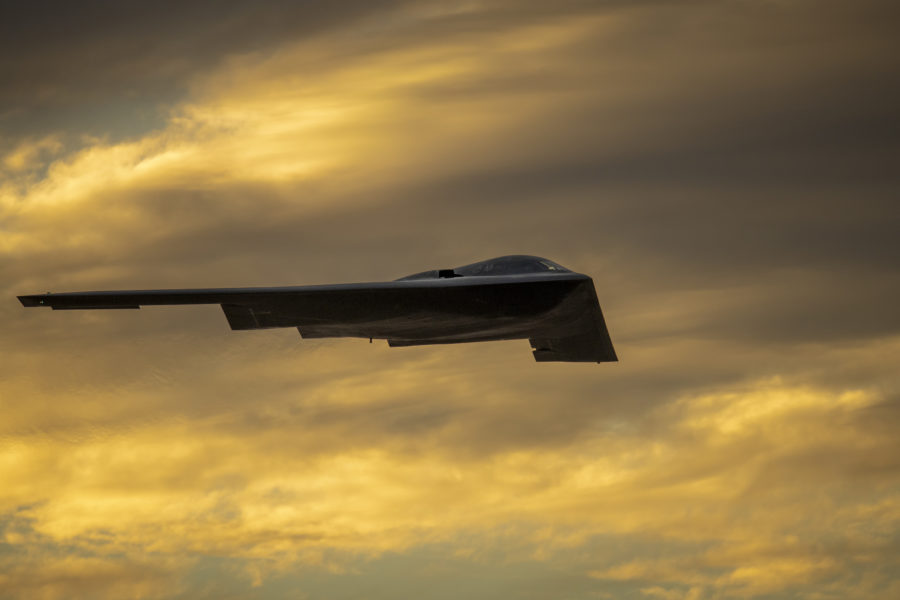The Air Force has decided it is too expensive to fix the B-2A Spirit bomber that crashed at Whiteman Air Force Base, Mo., in December 2022, and will retire it from service, Air & Space Forces Magazine has confirmed. The decision is likely driven by the cost and duration of a potential repair.
An April force structure report issued by the Pentagon said the aircraft “is being divested in FY 2025 due to a ground accident/damage presumed to be uneconomical to repair.” No cost estimate was provided. Aviation Week was the first to report the notice.
The action will reduce the B-2 fleet to 19 aircraft, out of the 21 originally built. The Spirit is the Air Force’s only penetrating bomber, meaning it is able to get past a peer adversary’s integrated air defense system.
In 2010, another B-2 crashed at Andersen Air Force Base, Guam. After months of effort, Airmen and Northrop Grumman personnel made it flyable and returned it to Northrop for full repair. That aircraft returned to service, but only after four years of work and a price estimated to be more than $100 million. At the time, the Air Force said it could not tolerate the loss of a single B-2, and that the effort required to bring the aircraft back to service was necessary and justified.
The Air Force’s fiscal 2025 budget request, along with a subsequent contract to Northrop Grumman to sustain the fleet, indicates that the B-2 fleet won’t serve very long after 2029. If the repairs needed on the December 2022 mishap aircraft are comparable to those required for the one that crashed at Guam, the Air Force likely decided the expense wasn’t worth the return, given that B-2 being retired would likely have only served a year or two before being replaced by the B-21.
The Air Force has only budgeted B-2 procurement and research and development through fiscal 2028, indicating it doesn’t plan to retain the type much beyond 2030. Northrop Grumman received a sustainment contract for the B-2 on May 3, valued at up to $7 billion, which only runs through 2029.
Asked if this funding profile maps the sunset of the B-2, an Air Force spokesperson said “the System Program Office determines the contract period of performance that best meets the needs of the effort. The Air Force remains committed to sustaining and modernizing the B-2 to maintain combat effectiveness until a sufficient number of B-21s are operational.”
Both R&D and procurement together for the B-2 are only estimated to be about $250 million through the future years defense plan, but the Northrop contract also includes depot maintenance and other sustainment.
As to how much of the $7 billion is expected to be exercised, the spokesperson said “the ceiling of the Flexible Acquisition and Sustainment Team (FAST) III contract is determined by the B-2 System Program Office … by several factors and is intended to provide the Air Force with the flexibility necessary to meet operational requirements. The ceiling is a not-to-exceed amount and is deliberately set to accommodate any possible modernization or sustainment efforts.”
The Air Force has declined to say whether B-2s will be replaced by new B-21 Raiders on a one-for-one basis as they become available, but phase-out of the B-2 by 2029 would align with the anticipated delivery of the first 21 B-21s, which will be built in five fixed-price lots.
The first B-21 flew last November, and Northrop received a low-rate initial production contract for the Raider in December.
The B-2 being divested crashed on Dec. 10, 2022. After the crew declared an undisclosed in-flight emergency, the aircraft landed, ran off the runway, and caught fire. It remained on the side of the runway for some time, shutting down B-2 operations at Whiteman for a week afterwards. The fleet was grounded—the service called it a “safety pause”—for six months as the accident was analyzed, but a cause was not disclosed. The Air Force said the rest of the B-2 fleet could fly if needed during the flying stand-down.
In September 2021, another B-2 made an emergency landing at Whiteman and, again, veered off the runway when the left landing gear collapsed. That aircraft was patched up enough at Whiteman to fly to Northrop’s California facilities for further repair.
One B-2 has been lost in service. In 2008, a Spirit crashed on takeoff at Andersen, the accident later attributed to condensation in the air data system which gave faulty indications of the aircraft’s attitude, prompting the computer to command an excessive pitch-up. The bomber stalled and crashed, but the crew ejected and survived.
While the B-2 fleet numbers 20 aircraft, not all of them are available for combat at any time. Typically, at least one is in long-term depot maintenance at Northrop while two or three more are in heavy maintenance at Whiteman, and up to two are in flight test at Edwards Air Force Base, Calif. The Air Force has said it usually has 12-14 B-2s available for combat.
It hasn’t been decided yet what will be done with the condemned aircraft, a service spokesperson said. Depending on its condition, it might be used as a maintenance trainer, for engineering fit checks, or displayed, possibly at the Museum of the U.S. Air Force in Dayton, Ohio, or as a pole-mounted gate guard at Whiteman.


